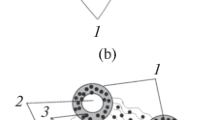Abstract
One polymer composite materials have been prepared using a difference in melting points between the components. This depends on the fact that aligned and extended chains provide thermodynamically more stable crystals, which thus will have higher melting points than conventionally crystallized melts. The growth of transcrystalline regions in the melt matrix at the interface plus an observed partial melting between fibre and matrix are indications of a strong and intimate interfacial bond with a gradient in morphologies for the system studied, high-density polyethylene. The pull-out test is a simple and adequate method for evaluating the interfacial shear strength of one polymer composites. The value for the high-density polyethylene composite falls between the strengths for glass-reinforced polyester and epoxy resins. However, the interfacial strength in the polyethylene composites is due mainly to the unique epitaxial bonding rather than the radial forces from compressive shrinkage. The low critical aspect ratio for the filaments in these polyethylene composites suggests possible advantageous uses as short fibrereinforced materials where the interfacial strength is a controlling factor.
Similar content being viewed by others
References
H. A. Clark andE. P. Pleuddemann,Mod. Plastics, June (1963) 133.
K. Ito,J. Polymer Sci. 45 (1960) 155
B. M. Vanderbilt,Mod. Plastics, September (1959) 125.
G. A. Cooper andA. Kelly, ASTM STP 452 (1969) p. 90.
N. J. Capiati andR. S. Porter,J. Polymer Sci., Polym. Phys. Ed. 13 (1975) 1177.
C. R. Desper, J. H. Southern, R. D. Ulrich andR. S. Porter,J. Appl. Phys. 41 (1970) 4284.
R. G. Crystal andJ. H. Southern,J. Polymer Sci. A2 9 (1971) 1641.
P. J. Miller, J. F. Jackson andR. S. Porter,ibid 11 (1973) 2001.
N. E. Weeks, Ph. D. Thesis, Polymer Science and Engineering, University of Massachusetts (1974).
L. H. Sharpe andH. Schonhorn,Amer. Chem. Soc. Adv. Chem. Ser. 43 (1964) 189.
N. J. Capiati, unpublished results.
N. M. Bikales, Ed., “Adhesion and Bonding” (Wiley-Interscience, New York, 1971) Ch.4.
“Adhesion, Fundamentals and Practice” (The Ministry of Technology, UK, 1969) p. 12.
L. J. Broutman,Polymer Eng. Sci. 6 (1966) 263.
Prog. Report, MCA-MIT Plastics Research Proj., Plastics Research Laboratory, MIT, October 1, 1957.
A. Kelly,Proc. Roy. Soc. Lond. A319 (1970) 95.
A. Kelly andW. R. Tyson,J. Mech. Phys. Sol. 13 (6) (1965) 329.
L. J. Broutman andR. H. Korck, Eds., “Modern Composite Materials” (Addison-Wesley, 1967) Ch. 13.
A. C. Bernardo,SPE J. 26 October (1970) 39.
Author information
Authors and Affiliations
Additional information
On leave from Universidad Nacional Del Sur, Planta Piloto de Ingenieria Quimica, Bahia Blanca, Argentina.
Rights and permissions
About this article
Cite this article
Capiati, N.J., Porter, R.S. The concept of one polymer composites modelled with high density polyethylene. J Mater Sci 10, 1671–1677 (1975). https://doi.org/10.1007/BF00554928
Received:
Accepted:
Issue Date:
DOI: https://doi.org/10.1007/BF00554928



